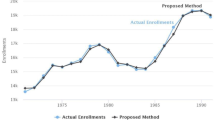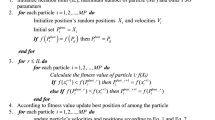Abstract
Non-stochastic hesitation in fuzzy time series forecasting methods occurs due to availability of more than one fuzzification methods of time series data. Recently hesitant fuzzy set has gained attention of the researchers to address issue of aforesaid non-stochastic hesitation. In this research paper, we propose and develop a computational algorithm-based method for financial time series forecasting using hesitant fuzzy set. The proposed method uses hesitant fuzzy logical relations that are constructed using triangular fuzzy sets with equal and unequal intervals. In the proposed forecasting method, hesitant fuzzy logical relations are aggregated using a hesitant fuzzy aggregation operator. Advantages of developed hesitant fuzzy set based forecasting method are that it is easy to implement, can cope with huge time series database and enhances the accuracy in financial time series forecast. To see the performance of proposed method in financial time series forecasting, it is implemented on two financial experimental dataset of TAIFEX and SBI share price at BSE. Rigorous comparison analysis of the proposed forecasting method is done by comparing it with other conventional and computational fuzzy time series forecasting methods in terms of RMSE, AFER. Significance of accuracy enhancement in forecasted outputs is also verified using two-tailed t test.

Similar content being viewed by others
References
Abhishekh, Gautam SS, Singh SR (2018a) A score function-based method of forecasting using intuitionistic fuzzy time series. New Math Nat Comput 14(01):91–111
Abhishekh, Gautam SS, Singh SR (2018b) A refined method of forecasting based on high-order intuitionistic fuzzy time series data. Prog Artif Intell 7:339. https://doi.org/10.1007/s13748-018-0152-x
Aladag CH, Basaran MA, Egrioglu E, Yolcu U, Uslu VR (2009) Forecasting in high order fuzzy times series by using neural networks to define fuzzy relations. Expert Syst Appl 36(3):4228–4231
Aladag CH, Yolcu U, Egrioglu E, Dalar AZ (2012) A new time invariant fuzzy time series forecasting method based on particle swarm optimization. Appl Soft Comput 12(10):3291–3299
Alpaslan F, Cagcag O, Aladag CH, Yolcu U, Egrioglu E (2012) A novel seasonal fuzzy time series method. Hacet J Math Stat 41(3):375–385
Askari S, Montazerin N, Zarandi MF (2015) A clustering based forecasting algorithm for multivariable fuzzy time series using linear combinations of independent variables. Appl Soft Comput 35:151–160
Atanassov KT (1986) Intuitionistic fuzzy sets. Fuzzy Sets Syst 20(1):87–96
Bas E, Yolcu U, Egrioglu E, Aladag CH (2015) A fuzzy time series forecasting method based on operation of union and feed forward artificial neural network. Am J Intell Syst 5(3):81–91
Bas E, Egrioglu E, Yolcu U et al (2018) Type 1 fuzzy function approach based on ridge regression for forecasting. Granul Comput. https://doi.org/10.1007/s41066-018-0115-4
Bisht K, Kumar S (2016) Fuzzy time series forecasting method based on hesitant fuzzy sets. Expert Syst Appl 64:557–568
Bisht K, Joshi DK, Kumar S (2018) Dual Hesitant Fuzzy Set-Based Intuitionistic Fuzzy Time Series Forecasting. In: Perez G, Tiwari S, Trivedi M, Mishra K (eds) Ambient communications and computer systems. Advances in intelligent systems and computing, vol 696. Springer, Singapore
Bose M, Mali K (2018) A novel data partitioning and rule selection technique for modeling high-order fuzzy time series. Appl Soft Comput 63:87–96
Chen SM (1996) Forecasting enrollments based on fuzzy time series. Fuzzy sets syst 81(3):311–319
Chen SM, Chang YC (2011) Weighted fuzzy rule interpolation based on GA-based weight-learning techniques. IEEE Trans Fuzzy Syst 19(4):729–744
Chen SM, Lee CH (1999) New methods for students′ evaluation using fuzzy sets. Fuzzy Sets Syst 104(2):209–218
Chen SM, Phuong BDH (2017) Fuzzy time series forecasting based on optimal partitions of intervals and optimal weighting vectors. Knowl-Based Syst 118:204–216
Chen SM, Tanuwijaya K (2011a) Multivariate fuzzy forecasting based on fuzzy time series and automatic clustering techniques. Expert Syst Appl 38(8):10594–10605
Chen SM, Tanuwijaya K (2011b) Fuzzy forecasting based on high-order fuzzy logical relationships and automatic clustering techniques. Expert Syst Appl 38(12):15425–15437
Chen SM, Lee SH, Lee CH (2001) A new method for generating fuzzy rules from numerical data for handling classification problems. Appl Artif Intell 15(7):645–664
Chen SM, Munif A, Chen GS, Liu HC, Kuo BC (2012) Fuzzy risk analysis based on ranking generalized fuzzy numbers with different left heights and right heights. Expert Syst Appl 39(7):6320–6334
Cheng CH, Chang JR, Yeh CA (2006) Entropy-based and trapezoid fuzzification-based fuzzy time series approaches for forecasting IT project cost. Technol Forecast Soc Chang 73(5):524–542
Cheng CH, Cheng GW, Wang JW (2008) Multi-attribute fuzzy time series method based on fuzzy clustering. Expert Syst Appl 34(2):1235–1242
Dallal GE, Wilkinson L (1986) An analytic approximation to the distribution of Lilliefors′s test statistic for normality. Am Stat 40(4):294–296
Efendi R, Arbaiy N, Deris MM (2018) A new procedure in stock market forecasting based on fuzzy random auto-regression time series model. Inf Sci 441:113–132
Egrioglu E, Aladag CH, Yolcu U, Uslu VR, Basaran MA (2010) Finding an optimal interval length in high order fuzzy time series. Expert Syst Appl 37(7):5052–5055
Gangwar SS, Kumar S (2012) Partitions based computational method for high-order fuzzy time series forecasting. Expert Syst Appl 39(15):12158–12164
Gupta KK, Kumar S (2018) Hesitant probabilistic fuzzy set based time series forecasting method. Granul Comput. https://doi.org/10.1007/s41066-018-0126-1
Hsu LY, Horng SJ, Kao TW, Chen YH, Run RS, Chen RJ, Lai JL, Kuo IH (2010) Temperature prediction and TAIFEX forecasting based on fuzzy relationships and MTPSO techniques. Expert Syst Appl 37(4):2756–2770
Huarng K, Yu THK (2006) Ratio-based lengths of intervals to improve fuzzy time series forecasting. IEEE Trans Syst Man Cybern Part B (Cybern) 36(2):328–340
Jang JS (1993) ANFIS: adaptive-network-based fuzzy inference system. IEEE Trans Syst Man Cybern 23(3):665–685
Joshi BP, Kumar S (2012a) A computational method of forecasting based on intuitionistic fuzzy sets and fuzzy time series. In: Deep K, Nagar A, Pant M, Bansal J (eds) Proceedings of the international conference on soft computing for problem solving (SocProS 2011) December 20–22, 2011. Advances in Intelligent and Soft Computing, vol 131. Springer, New Delhi
Joshi BP, Kumar S (2012b) Intuitionistic fuzzy sets based method for fuzzy time series forecasting. Cybern Syst 43(1):34–47
Joshi BP, Kumar S (2013) A computational method for fuzzy time series forecasting based on difference parameters. Int J Model Simulat Sci Comput 4(01):1250
Kocak C (2017) ARMA (p, q) type high order fuzzy time series forecast method based on fuzzy logic relations. Appl Soft Comput 58:92–103
Kumar S, Gangwar SS (2015) Intuitionistic fuzzy time series: an approach for handling nondeterminism in time series forecasting. IEEE Trans Fuzzy Syst 24(6):1270–1281
Lee LW, Wang LH, Chen SM (2007) Temperature prediction and TAIFEX forecasting based on fuzzy logical relationships and genetic algorithms. Expert Syst Appl 33(3):539–550
Lee LW, Wang LH, Chen SM (2008) Temperature prediction and TAIFEX forecasting based on high-order fuzzy logical relationships and genetic simulated annealing techniques. Expert Syst Appl 34(1):328–336
Lee CL, Kuo SC, Lin CJ (2017) An efficient forecasting model based on an improved fuzzy time series and a modified group search optimizer. Appl Intell 46(3):641–651
Liu HT, Wei ML (2010) An improved fuzzy forecasting method for seasonal time series. Expert Syst Appl 37(9):6310–6318
Maciel L, Ballini R, Gomide F (2016) Evolving granular analytics for interval time series forecasting. Granul Comput 1:213. https://doi.org/10.1007/s41066-016-0016-3
Pathak HK, Singh P (2011) A new bandwidth interval based forecasting method for enrollments using fuzzy time series. Appl Math 2(04):504–507
Rubio A, Bermúdez JD, Vercher E (2017) Improving stock index forecasts by using a new weighted fuzzy-trend time series method. Expert Syst Appl 76:12–20
Singh SR (2007a) A simple method of forecasting based on fuzzy time series. Appl Math Comput 186:330–339
Singh SR (2007b) A robust method of forecasting based on fuzzy time series. Appl Math Comput 188(1):472–484
Singh SR (2008) A computational method of forecasting based on fuzzy time series. Math Comput Simul 79(3):539–554
Singh SR (2009) A computational method of forecasting based on high-order fuzzy time series. Expert Syst Appl 36(7):10551–10559
Singh P, Borah B (2013) An efficient time series forecasting model based on fuzzy time series. Eng Appl Artif Intell 26(10):2443–2457
Song Q, Chissom BS (1993) Fuzzy time series and its models. Fuzzy Sets Syst 54(3):269–277
Song Q, Chissom BS (1994) Forecasting enrollments with fuzzy time series—part II. Fuzzy Sets Syst 62(1):1–8
Tak N, Evren AA, Tez M, Egrioglu E (2018) Recurrent type-1 fuzzy functions approach for time series forecasting. Appl Intell 48(1):68–77
Torra V, Narukawa Y (2009) On hesitant fuzzy sets and decision. In: Fuzzy systems, FUZZY-IEEE 2009, IEEE international conference:1378–1382
Wang HY, Chen SM (2008) Evaluating students′ answer scripts using fuzzy numbers associated with degrees of confidence. IEEE Trans Fuzzy Syst 16(2):403–415
Wang NY, Chen SM (2009) Temperature prediction and TAIFEX forecasting based on automatic clustering techniques and two-factors high-order fuzzy time series. Expert Syst Appl 36(2):2143–2154
Wang L, Liu X, Pedrycz W (2013) Effective intervals determined by information granules to improve forecasting in fuzzy time series. Expert Syst Appl 40(14):5673–5679
Wang YN, Lei Y, Fan X, Wang Y (2016) Intuitionistic fuzzy time series forecasting model based on intuitionistic fuzzy reasoning. Math Probl Eng. https://doi.org/10.1155/2016/5035160
Xia M, Xu Z (2011) Hesitant fuzzy information aggregation in decision making. Int J approx Reason 52(3):395–407
Xia M, Xu Z, Chen N (2013) Some hesitant fuzzy aggregation operators with their application in group decision making. Group Decis Negot 22(2):259–279
Yolcu OC, Alpaslan F (2018) Prediction of TAIEX based on hybrid fuzzy time series model with single optimization process. Appl Soft Comput 66:18–33
Yolcu OC, Yolcu U, Egrioglu E, Aladag CH (2016) High order fuzzy time series forecasting method based on an intersection operation. Appl Math Model 40:8750–8765
Zadeh LA (1965) Fuzzy sets. Inf Control 8:338–353
Zhu B, Xu Z, Xia M (2012a) Dual hesitant fuzzy sets. J Appl Math. https://doi.org/10.1155/2012/879629
Zhu B, Xu Z, Xia M (2012b) Hesitant fuzzy geometric Bonferroni means. Inf Sci 205:72–85
Author information
Authors and Affiliations
Corresponding author
Additional information
Publisher’s Note
Springer Nature remains neutral with regard to jurisdictional claims in published maps and institutional affiliations.
Rights and permissions
About this article
Cite this article
Bisht, K., Kumar, S. Hesitant fuzzy set based computational method for financial time series forecasting. Granul. Comput. 4, 655–669 (2019). https://doi.org/10.1007/s41066-018-00144-4
Received:
Accepted:
Published:
Issue Date:
DOI: https://doi.org/10.1007/s41066-018-00144-4




